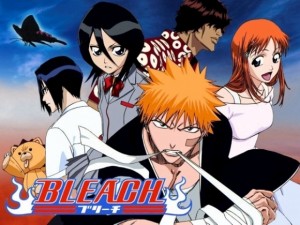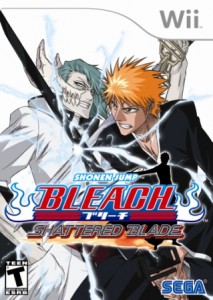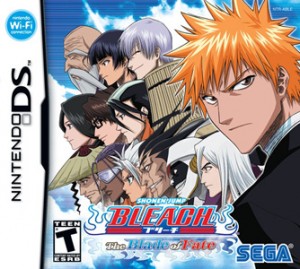$20 Game of the Week: Special Bleach Edition (Nintendo DS and Nintendo Wii)
by William Talley, filed in $20 Game Of The Week, Games, Reviews on Aug.12, 2008
 Bleach, shown Saturday nights on Cartoon Network’s Adult Swim, is one of the most watched anime shows among adults and teens. If not for its late night time slot and liberal amounts of blood and cleavage, it would be popular with younger viewers as well. Based on Shonen Jump’s manga of the same name, the series centers around Ichigo Kurosaki, a teenager who has the ability to see the spirits of the dead. When a mysterious woman visits him, he is attacked by a creature known as a hollow. To defend himself and his family, he takes his strange visitor’s power and uses it to become a Soul Reaper, (or Shinigami as they are known in the Japanese version) who are samurai-like warriors who have special abilities they use to defeat hollows. While the series has nearly reached 200 episodes in Japan, it recently returned to U.S. TV last March after a brief hiatus, and at the time of this writing, it’s only at 77 episodes, so North American fans who don’t watch the online fansubs still have much to look forward to. While it may not be as huge and popular as Naruto, Dragon Ball Z, or Pokemon, Bleach has devoted a fairly large fanbase, and there is a decent variety of merchandise available for fans. There have been action figures, a collectible card game, English translations of the original manga, and most importantly, video games. Thus far, Sega has published two Bleach games on U.S. shores, one of which, Bleach: The Blade of Fate for the Nintendo DS, is this week’s $20 game of the week. As a special bonus, we’ll take a look at the other game, Bleach: Shattered Blade for the Nintendo Wii. Both of these games are fighters, and both vary in degrees of quality. Die hard fans of the series probably already have these two games, but more moderate fans will probably be on the fence about them. So if you want the word on how well these games play, continue forward.
Bleach, shown Saturday nights on Cartoon Network’s Adult Swim, is one of the most watched anime shows among adults and teens. If not for its late night time slot and liberal amounts of blood and cleavage, it would be popular with younger viewers as well. Based on Shonen Jump’s manga of the same name, the series centers around Ichigo Kurosaki, a teenager who has the ability to see the spirits of the dead. When a mysterious woman visits him, he is attacked by a creature known as a hollow. To defend himself and his family, he takes his strange visitor’s power and uses it to become a Soul Reaper, (or Shinigami as they are known in the Japanese version) who are samurai-like warriors who have special abilities they use to defeat hollows. While the series has nearly reached 200 episodes in Japan, it recently returned to U.S. TV last March after a brief hiatus, and at the time of this writing, it’s only at 77 episodes, so North American fans who don’t watch the online fansubs still have much to look forward to. While it may not be as huge and popular as Naruto, Dragon Ball Z, or Pokemon, Bleach has devoted a fairly large fanbase, and there is a decent variety of merchandise available for fans. There have been action figures, a collectible card game, English translations of the original manga, and most importantly, video games. Thus far, Sega has published two Bleach games on U.S. shores, one of which, Bleach: The Blade of Fate for the Nintendo DS, is this week’s $20 game of the week. As a special bonus, we’ll take a look at the other game, Bleach: Shattered Blade for the Nintendo Wii. Both of these games are fighters, and both vary in degrees of quality. Die hard fans of the series probably already have these two games, but more moderate fans will probably be on the fence about them. So if you want the word on how well these games play, continue forward.
Review: Bleach – Shattered Blade (Nintendo Wii)

As a fan of the show, a fan of fighting games, and a Wii owner who at the time was desperate for something to tide him over until Smash Brothers Brawl was released, I really wanted to like this game. There is certainly a lot to like about it. The game has a huge cast of fighters, a game-exclusive storyline featuring a new character who serves as the final boss, and several unlockable features. However, the game falls short with its motion-sensing gameplay. On the surface, things seem kosher. You preform attacks by preforming slashing, thrusting, and chopping motions with the WiiMote. Holding down A while doing the motions preforms special moves, holding B preforms super attacks, and waggling the nunchuck activates Bankai, in which your character becomes supercharged and has access to a new form and new attacks (that’s the gist of it, they go into further detail of what exactly this is during the show). You also have blocking and dodge maneuvers. Seems simple enough, but here is where the problem comes into play. More often than not, matches degenerate from matches of skill to frantic WiiMote swingfests, which are pretty much the Wii equivalent to the button mashfests of fighting games past and present, and hardcore fighting game fans tend to look down on that. That normally wouldn’t be a completely bad thing, but unfortunately the action tends to get frantic along with it. In fact, it’s so frantic that it’s hard to keep up track of what’s going on. When you and your opponent swipe at each other so often to tell who landed the hit and who received it. There is a sword clash minigame, but that moves so fast, that it’s hard to keep track with as well, and it will be difficult to figure out when to make the correct swing. It doesn’t help matters that the game sometimes misreads your swipes. In a less serious offense, the backgrounds are a bit bland.
This seems to be another unfortunate case of Wiimote developers attempting to shoehorn WiiMote functionality where it isn’t necessary, particularly in a fighting game. That’s not to say that it’s impossible for a Wii fighting game to be done using motion control, just that it won’t work the way Shattered Blade does it. Of course this game isn’t a total wreck, and it’s presentation does a good job of satisfying its fanbase. As stated earlier, this game features a pretty large cast of fighters, and there are even a few who at the time of this game’s release, had yet to debut on U.S. television. Most of the English voice actors from the series are here, and for the most part, the dialogue is spot on. Indeed, while fighting game aficionados won’t be too thrilled with the game’s lack of strategy, fans of the show will be more forgiving of its faults. If the developers took spent as much effort with the gameplay as it did with catering to the fans, then the Wii would have had an excellent fighting game and an awesome third party release, both of which are rarities on the system.
$20 Game of the Week: Bleach – The Blade of Fate(Nintendo DS)

The Blade of Fate on the other hand, is another story. Not only does it do a good job of satisfying its fanbase, but it also packs in a solid fighting game engine, and it pushes the Nintendo DS to its limits to offer one of the best fighting experiences seen on a handheld game system. Much of this is thanks to developer Treasure, whom you know from games such as Ikaruga and Gunstar Heroes. Loosely based on the Soul Society Rescue Arc, Ichigo and his allies infiltrate the Soul Society in an attempt to rescue their friend Rukia, who is slated to be executed. There, he battles the captains and lieutenants of the 13 court guard squads, and helps to uncover a conspiracy within the Soul Society itself. Before long, all h-e-hockey sticks has broken loose, and before it’s all over, you’re gonna have to do a lot of fighting.
Thankfully, you’ll enjoy the fighting. The fighting system is actually pretty deep for both a game based on an anime, and a Nintendo DS fighter in general. You have low, medium, and high attacks, blocking, and a flash step maneuver, which transports you either from or away the action. There are times where there will be more than one opponent on the screen, and things will get hectic. Fortunately in these matches, there is more than one level of action, and just like in the old-school Fatal Fury games, there is a line jump maneuver to switch between those levels. You also have access to special attacks, super moves, and your character’s supercharged Bankai form. Of course, you can’t simply spam these moves, as you have to keep an eye on both your spiritual power (the three-part bar at the bottom of the screen) and your spiritual pressure (the number next to your life gauge). They’ll both fill up over time, but if you keep using certain techniques, then you’ll find that you can’t flash step or line jump when you need to do it the most. Perhaps the biggest part of the system is the card deck. You have access to several cards throughout the match, and they activate special tricks, from increasing attack and defense to reversing your opponent’s controls. You’ll unlock several cards throughout the game, and you can even customize your deck before you play. You activate them using the touch screen. If you have difficulty with the control motions, then you can also access your special moves via touch screen. The touch screen features make the game a little bit noob friendly, but at the same time the cards add a layer of strategy to matches, as a good deck will be deadly in the hands of a skilled player.
The presentation isn’t bad either. There are 28 fighters, many of which have to be unlocked. Nearly every major player from the series at that time is in the game, and several of them have unique storylines which also have to be unlocked. The 2-d sprites are well drawn, and the camera zooms in and out during gameplay. The backgrounds are vibrant, and there are a lot of small details you’ll notice if you pay close attention. The soundtrack isn’t bad either. The fighters have their vocals done by the English voice cast from the show, and the game even opens with High and Mighty Color’s Ichirinno Hana, which is the third opening theme of the show. At the Urahara shop, you can spend the points you earn during the game to unlock soundtracks, art pieces, and spirit cards for your deck. Along with story mode, the game also has arcade, training, versus, and challenge modes. There are even several multiplayer modes, and you can play then either locally (regardless of weather or not each player has their own card) or using Nintendo Wi-Fi. There are a few things that bother me about story mode. Although there are multiple paths throughout the game for some characters, only one is the ‘right’ path, and unless you deduce what it is, you’ll find yourself repeating matches and fighting the same opponents over and over again. Also, there are some characters whose storylines are only 2 or 3 levels long. It’s almost like every character’s story contains bits and pieces of a larger story.
Even with that flaw, Blade of Fate does an awesome job of representing its source material. In addition, it succeeds in delivering a fighting experience worthy of standing alongside the Fatal Fury, Street Fighter, and Guilty Gear as one of the genre’s finest entries. Fans of the show will appreciate how well the game captures the best parts of their favorite series, and fighting game fans will appreciate the game’s deep fighting system. A sequel is headed to DS this fall with even more features, so if you haven’t already, pick this game up.


 PS3
PS3
 Famicom Dojo
Famicom Dojo KEEP PLAYING
KEEP PLAYING KEEP PLAYING: Rewind
KEEP PLAYING: Rewind Powet Toys
Powet Toys Powetcast
Powetcast Hitchhiker's Guide POWETcast
Hitchhiker's Guide POWETcast














